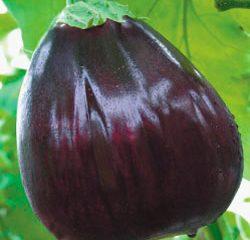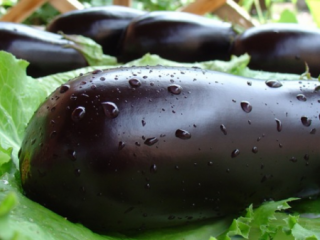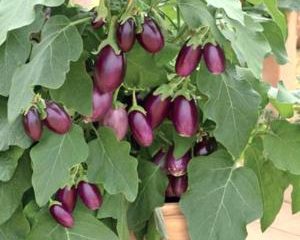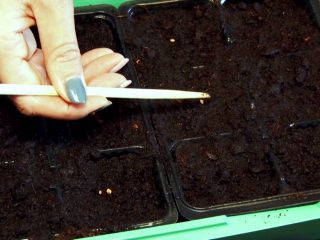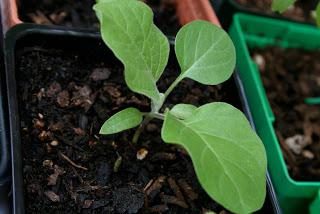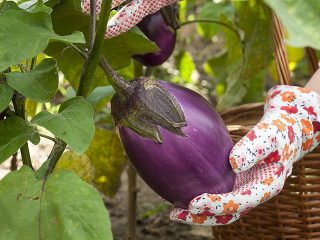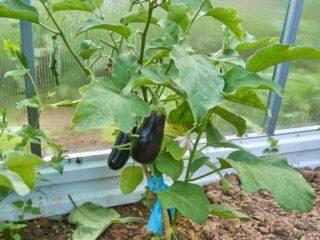Content
- 1 Why do eggplants get sick?
- 2 Eggplant diseases in a greenhouse: description with photographs
- 2.1 Blackleg
- 2.2 Curling leaves
- 2.3 Powdery mildew
- 2.4 Black spot
- 2.5 Yellowness of leaves
- 2.6 Phytoplasmosis (stolbur)
- 2.7 Phomopsis
- 2.8 Cercospora
- 2.9 Late blight
- 2.10 White rot (sclerotinia)
- 2.11 Gray rot (alternaria blight)
- 2.12 Dry rot (Phomopsis)
- 2.13 Verticillium wilt
- 2.14 Tobacco mosaic
- 2.15 Internal necrosis
- 2.16 Apical rot
- 3 Disease Prevention
- 4 Conclusion
Diseases of eggplants in a greenhouse have different causes, most often they are associated with violation of the rules of care. For example, gardeners water plants abundantly, which creates a humid environment favorable for fungi and bacteria. There may also be objective reasons related to the weather.
Why do eggplants get sick?
Diseases of eggplants in a greenhouse appear for various reasons, they are mainly associated with improper care:
- insufficient lighting - plants do not tolerate shade;
- lack or excess of water - the soil should always remain moderately moist;
- watering with cold water;
- deficiency of nutrients, including microelements (for example, due to a lack of calcium, a disease of eggplants in a greenhouse, called blossom end rot, develops);
- lack of ventilation of the greenhouse, stagnation of moist air;
- sudden temperature changes (eggplant seedlings are transferred to the greenhouse no earlier than the second half of May).
Eggplant diseases in a greenhouse: description with photographs
When grown in a greenhouse, plants can suffer from various diseases. Infectious pathologies of a fungal, viral or bacterial nature are particularly dangerous. The most common diseases with photos and methods of their treatment are described below.
Blackleg
The main sign of pathology is blackening of the root collar and the formation of a gray coating on it. Gradually, the weakened plant dries out, and then the fungus moves to the roots. This is dangerous for eggplants in the greenhouse, as well as at the stage of growing seedlings.
If signs of pathology are detected, it is necessary to treat with Trichodermin. But if this does not help, the affected bushes must be removed immediately, since they will not recover and will infect healthy plantings. The soil is dried and loosened, then sprinkled with wood ash.
Since it is quite difficult to cure this disease in a greenhouse, plant seeds must be treated before sowing. To do this, they can be kept in a weak solution of potassium permanganate or Fundazol.
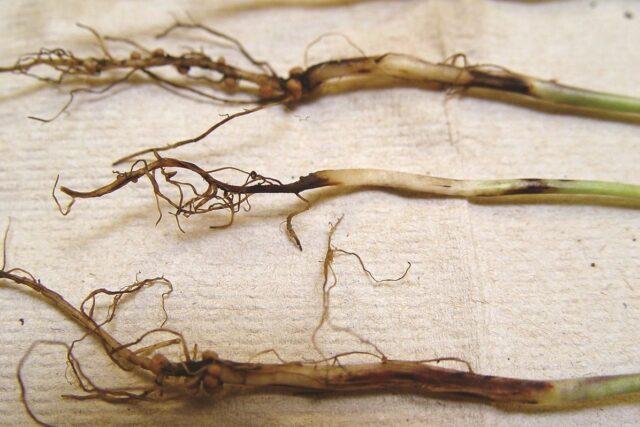
Signs of blackleg - blackening of the root collar
The main provoking factors are sudden temperature changes, high humidity and dense plantings.
Curling leaves
Curling of leaves can be due to a variety of reasons, mainly due to insufficient care:
- deficiency of potassium compounds;
- stagnation of water due to excessive watering;
- invasion of aphids, spider mites;
- lack of lighting.
To accurately determine the root cause, you need to carefully examine the eggplants in the greenhouse.If their leaves are covered with cobwebs, it is due to spider mites. An aphid invasion is also quite easy to detect - clusters of insects are visible to the naked eye. To treat the disease, eggplants are treated with insecticides:
- "Karate";
- "Biotlin";
- "Match";
- "Agravertin" and others.
It is also worth adding potassium sulfate (30 g per 10 l) to the soil, eliminating the cause of the shadow and normalizing watering.
Powdery mildew
Signs of this disease of eggplants in a greenhouse are:
- white bloom on the lower foliage;
- infection of the upper leaves;
- the fruits become covered with a powdery coating and crack;
- Balls form on the upper parts of the leaves.
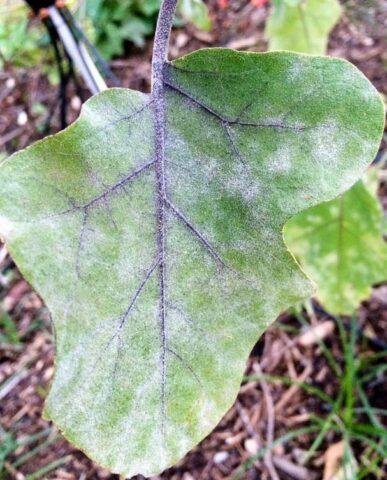
Eggplant leaf affected by powdery mildew
For processing it is recommended to use “Gaupsin” or “Trichodermin”. These are the most effective biological preparations that can be used even at the fruiting stage, including shortly before harvest.
Black spot
This disease also often affects eggplants in the greenhouse. First, black spots with a yellow border form on the leaves. Gradually they increase in size. Dots of a dark shade appear on the fruits; they have a blurred, “watery” border.
The disease often develops in a greenhouse due to lack of ventilation and high humidity. Hot weather also contributes - bacteria that cause infection develop well in the range of 27-30 degrees. There is no adequate treatment - the affected bushes are removed, and the rest are treated with Zaslon or Fitoflavin-300.
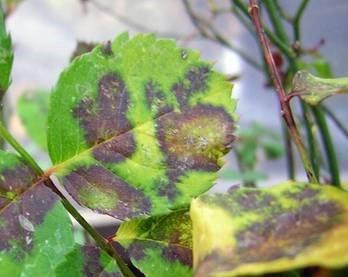
Leaf affected by black spot
Yellowness of leaves
Another common disease of eggplants in a greenhouse is yellowing of the leaves. It is associated with various reasons:
- nitrogen or potassium deficiency;
- too bright sun, scorching rays;
- when watering, water gets on the leaves, which leads to burns;
- Fusarium wilt is a dangerous fungal disease.
To eliminate the cause, it is necessary to improve the conditions of care. Young seedlings are shaded with a white shield so that they do not suffer from excess solar energy. You only need to water the eggplants at the roots, and it is advisable to do this in the evening. During the season, fertilizers are applied several times - first with nitrogen, and during the formation of buds - with potassium and phosphorus. If the cause of yellowing is associated with fusarium, treatment is carried out with Falcon.
Phytoplasmosis (stolbur)
This is a dangerous disease that affects eggplants most often in open ground, less often in greenhouses. It is caused by special pathogenic microorganisms – mycoplasmas. The main signs are:
- the leaves turn pale and acquire a yellowish color;
- then they curl and become wrinkled;
- begin to fade;
- flower clusters grow upwards, not downwards.
There is no adequate treatment - the plant must simply be removed from the site, then the soil must be deeply plowed and watered with a solution of any fungicide. For prevention, it is recommended to constantly remove weeds and destroy insects that carry the infectious agent.
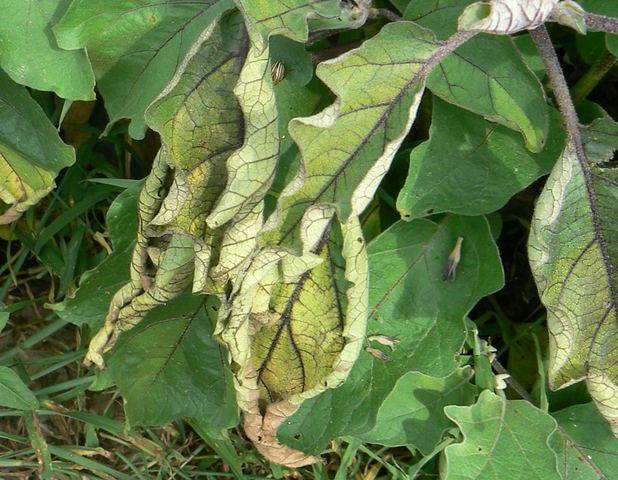
Symptoms of stolbur can be identified by examining plants
Phomopsis
Signs of this disease appear on different parts - leaves, petioles, shoots and fruits. The main symptoms are:
- dark brown, gray spots with chlorotic edges form on the foliage;
- they grow and take cuttings;
- tissues die, tops dry out;
- grayish spots appear on the stems;
- Dark brown dots form on the fruits and they partially soften.
The pathology is infectious in nature, it is caused by fungi.For prevention, it is recommended to treat the seeds, as well as treat them with fungicides, for example, Bordeaux mixture or copper oxychloride.
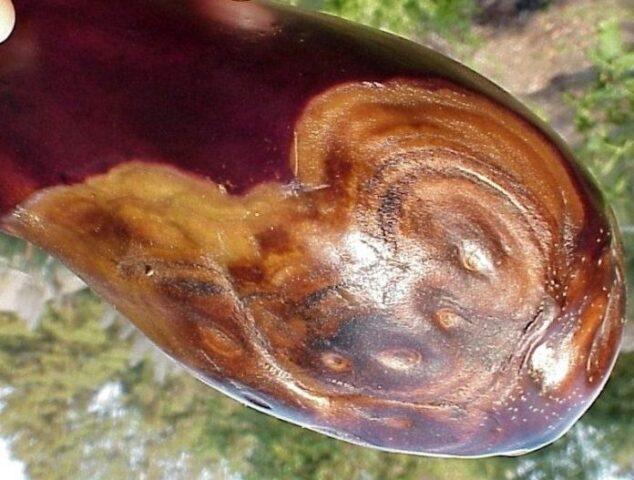
Fruit affected by Phomopsis is not suitable for consumption.
Cercospora
Cercospora blight is a disease that is often observed in greenhouses. Affects leaves, shoots and stalks. Round chlorotic spots appear on them. They gradually increase in size, after which the affected leaves begin to fall off. At the same time, the fruits themselves become small and stop developing.
The pathology is associated with fungi that are spread with water and through contact with garden tools. The main preventive measure is compliance with watering norms and crop rotation rules. Bordeaux mixture and fungicidal preparations are used for treatment.
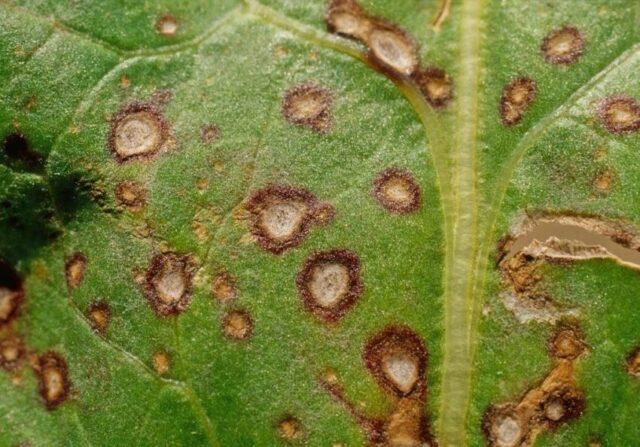
Signs of cercospora blight on foliage are easy to identify with the naked eye.
Late blight
A fungal disease that affects eggplants, peppers, tomatoes, potatoes in greenhouses and in open ground. It appears as brown-red spots with green edges on the outside of the foliage. A whitish coating appears inside, after which the fungus spreads to the fruit. They begin to deform and rot.
The main method of treating this disease of eggplants in a greenhouse is treatment with drugs:
- "Quadris";
- "Antrakol";
- "Consento";
- copper sulfate.
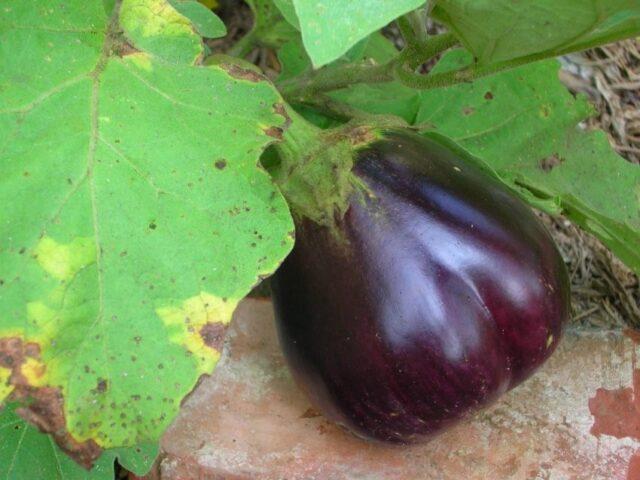
Signs of late blight - deformed fruits
White rot (sclerotinia)
Sclerotinia is another fungal disease that affects eggplants in the greenhouse. It affects first the roots, and then all other parts of the plant. A white coating is noticeable on the stems. The internal parts become compacted, sclerotia form on them, after which they soften and interfere with the movement of water through plant tissues.Dark spots appear on leaves and fruits. For treatment, it is necessary to remove the affected parts and sprinkle the sections with ash, and then treat them with copper-containing products.
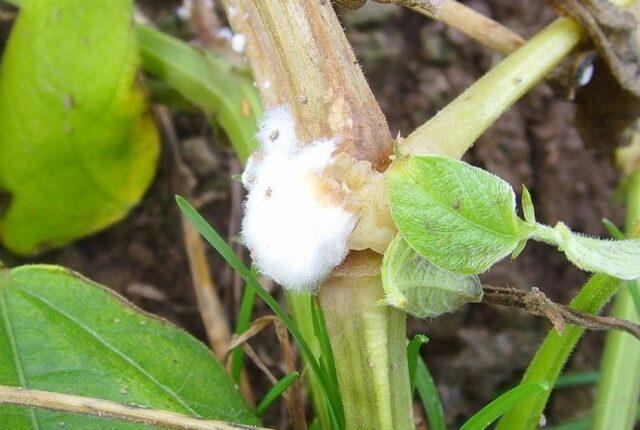
It is better to remove a stem affected by white rot from the site
Gray rot (alternaria blight)
Alternaria blight is a disease of eggplants that occurs in a greenhouse. It is of fungal origin. It can be identified by the following signs:
- round brown spots on the foliage and wet spots on the ovaries;
- the eggplants are pressed in and become soft;
- the fruits acquire an olive-gray, black color.
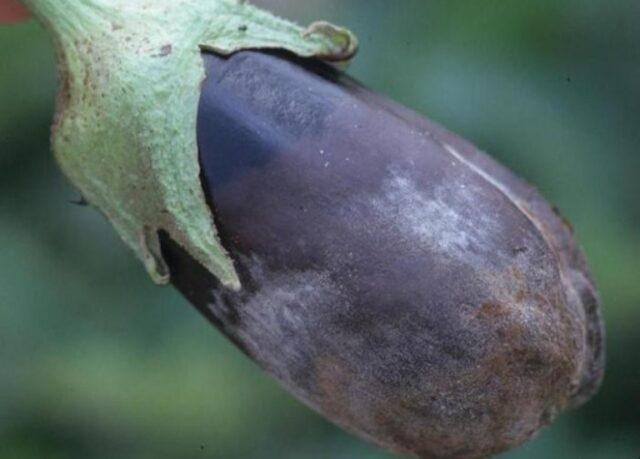
Signs of gray rot
The infection spreads through cracks, burns and other damage to eggplants. The pathogen can live in soil for up to two years. Affected plants must be dug up and taken away. For treatment, products based on copper and colloidal sulfur are used. The main preventive measures are compliance with watering norms and crop rotation rules.
Dry rot (Phomopsis)
Signs of Phomopsis in eggplants in a greenhouse appear in hot, dry weather. The sprouts become brown and rot, and wet ring rot is noticeable on the seedlings. Round spots with brown edges appear on the leaves of adult plants. Black dots are noticeable in the center - these are pycnidia of the fungus, the causative agent of the disease.
Spots also appear on the fruits. They increase in size and turn black, causing the eggplants to rot. To cope with the pathology, fungicides with active ingredients are used: prochloraz, mancozeb and chlorotolonil.
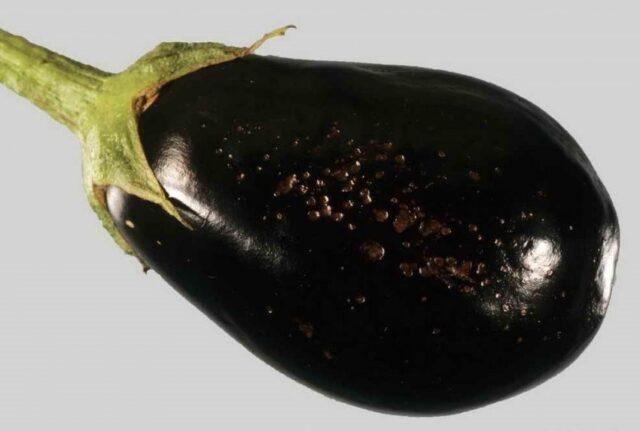
Fruit affected by Phomopsis
Verticillium wilt
Verticillium is a fungal disease that damages eggplants in a greenhouse and less often when grown in open ground. Fungi penetrate from the soil and release toxic substances.Provoking factors are warm weather and high humidity. The soil is watered with a solution of a biological preparation, for example, Fitosporin or Trichodermin.

Treatment of verticillium is useless - all that remains is to throw away the bushes.
Tobacco mosaic
A common viral disease of eggplants in greenhouses. The main signs are chlorotic, light green spots along the veins of the leaves. Some of the leaf blades acquire a speckled pattern, the veins lighten and become wrinkled. The fruits become smaller and lose their normal shape. There are no adequate methods of treatment - the affected plants can only be dug up and thrown away.
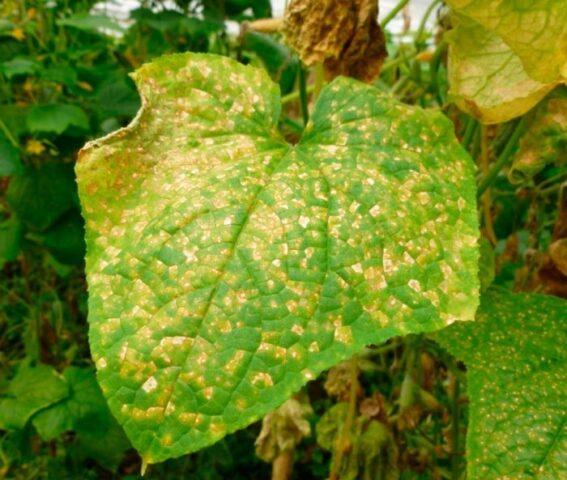
Signs of tobacco mosaic
Internal necrosis
Internal necrosis is the death of tissues of foliage, stems and other parts of eggplants. This disease develops both in greenhouses and in open ground. It is associated with bacteria and fungi that come from the soil and release toxic substances. Pathogenic processes develop in conditions of high temperature and humidity.
Treatment is impossible; the plants will have to be dug up and destroyed. The surface layer of soil is thrown away and replaced with a new one. Moreover, the soil is treated with biological preparations, for example, “Fitosporin” or “Trichophyte”.

A fruit affected by internal necrosis should not be eaten.
Apical rot
Blossom rot is a dangerous disease that affects seedlings and adult eggplant plants in a greenhouse. It manifests itself as light spots and rotten areas on the fruit.
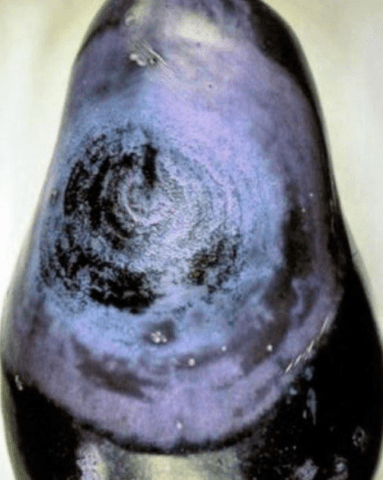
Blossom blossom may be due to calcium deficiency or plant pathogens
Calcium nitrate is added (foliar method, 10 g per 10 l) or treated with drugs, for example, Fitolavin and Fitomycin.
Disease Prevention
To treat eggplant diseases in a greenhouse, it is necessary to determine the signs of leaf damage, as in the photo. To avoid the development of such symptoms, certain preventive measures should be followed:
- Carefully select a variety suitable for the climatic conditions of a particular region.
- Choose the right place for plants - do not plant after tomatoes, peppers, potatoes. Good predecessors are cruciferous vegetables, legumes, onions and carrots.
- Plant at intervals of at least 50 cm.
- Plant seedlings only when the temperature reaches 15 degrees Celsius.
- Ventilate the greenhouse.
- Maintain proper watering.
- Loosen the soil regularly.
- Carry out preventive treatments with fungicides and insecticides.
Conclusion
Diseases of eggplants in a greenhouse are often associated with improper care. Plants prefer regular watering and are responsive to fertilizing. Water should be given so as not to flood the soil. It is important to ventilate the greenhouse and periodically inspect the plants. When the first signs of infection are detected, treatment is carried out.
